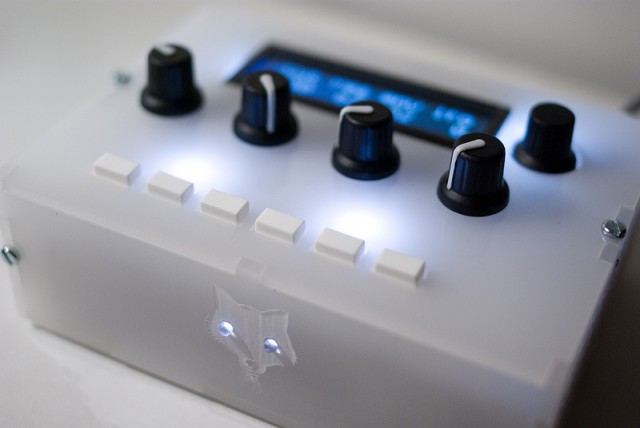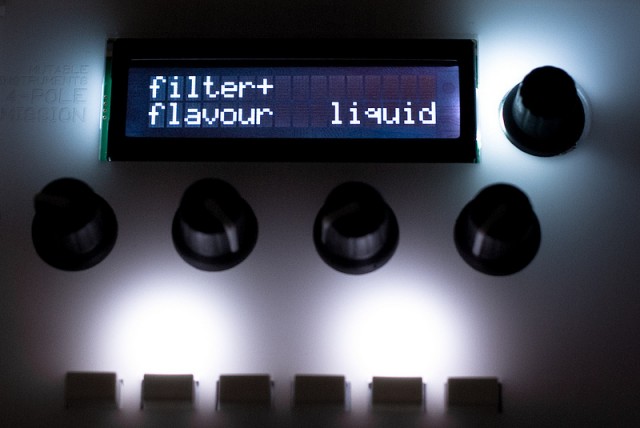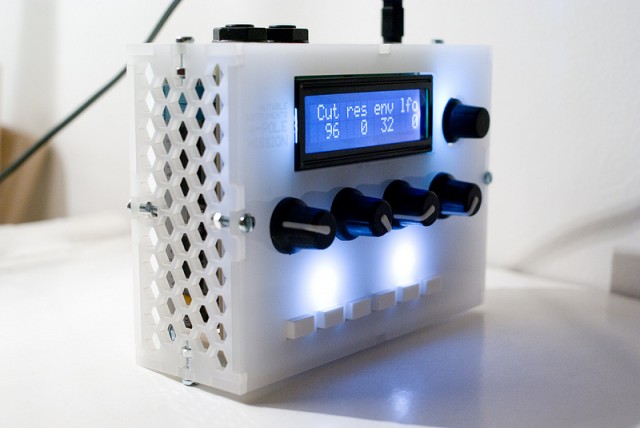Inside this compact white box lurks a lot of sonic power and technical prowess. Perhaps that explains why the newest version of the open source Shruthi-1 now sports a crazy-badass wolf dog cartoon with glowing eyes.
Since its launch, the Shruthi-1 has gradually evolved new features, with a fairly sophisticated combination of hardware and extensive software. At its core, it’s a “hybrid” synth with digital/virtual analog oscillators and real-analog filter. The digital oscillators allow it to change character, for classic virtual analog subtractive, or wavetable, FM, phase distortion, and vowel synthesis.
The big news with the filter is that the various flavors of filter board are now discontinued. Sadly, the wonderful CEM3379 filter chip is just too rare to have a long-term home in this synth; the Shruthi-1, like other synths (the Dark Energy being a recent example) has hit chip scarcity.
But in its place is something else new and wonderful. The SSM2164 (uh, that doesn’t roll of the tongue, but yes, that filter) combines 15 filter responses with four resonance models, for a total of 60 possible filter sounds. See also the Oberheim Matrix-12 and Xpander for pole-mixing techniques. You also get self-oscillation, and even a Korg DS-inspired diode waveshaper. (I won’t go into any more detail, as maker Mutable describes this in gory precision.)
In a way, the Shruthi-1 – despite its minimal knobs – really hides a semi-modular instrument, one with its own built-in arpeggiator, modulation matrix, duophony, rhythmical oscillator cycling, and lots of other features. If there’s a technical feature possible – just about any feature – the Shruthi-1 does it. Combined with that terrific filter and digital grunge, I think it’s a terrific deal in desktop synths.
In fact, my only real criticism is, it does so much, you’re likely to be stuck paging through menus – or should focus on MIDI programming – because of the minimal controls. I can see why members of the Shruthi-1 community have been building expansion controllers for it to get more hands-on control. But on the other hand, to me, it’s entirely worth the tradeoff going compact – even with a complex menu system. The result is a synth that’s far more affordable and portable. It’s a natural for MIDI users.
The new design is also unquestionably the best-looking Shruthi yet, thanks to translucent white plexiglass and white LED lighting. 130 € buys you the kit (plus another 20 € in parts), but I’d strongly recommend the pre-assembled version if you’re less familiar with bigger builds. There are a lot of parts and two boards, plus a pretty white circuit board that will look grimy if you don’t solder carefully. For experienced builders, it should be a great assembly process into which you’ll want to sink your teeth, wolf-like. But for less-experienced builders – or just people who want to get straight to making sound – I think 349 € is a small price to ask. (A carry bag and European wall wart are included.) Just grab the pre-built version fast; because they’re hand-assembled, they won’t last long.
Full details:
Shruthi-1, 4-Pole Mission edition
Be sure to have a listen to the way the new stuff sounds:
The other important thing to mention about the Shruthi-1 is that it’s a fully open source synth. (An earlier version prohibited commercial use, but it now uses a more permissive license.) The best way to see what lurks inside is to check out GitHub. Apart from being able to modify the Shruthi-1 hardware and software design, there’s a library you can use in your own projects:
https://github.com/pichenettes/shruthi-1
This also means the Shruthi-1 joins our own MeeBlip among open source synths. I’ve been a bit amused at people comparing the two, because what I like about the Shruthi is that it’s basically MeeBlip’s opposite. We kept the design of the MeeBlip as minimal as possible, both with an eye to keeping one-to-one hardware controls and making modification simpler. The Shruthi is lovely because it’s the reverse: it retains a small footprint, but packs lots of sonic options. It’s the maximal alternative.
I’m just happy that the hardware landscape in general offers loads of great choices for people wanting to augment their computer soft synths with hardware. Who says the synthesizer’s best days are in the past?


